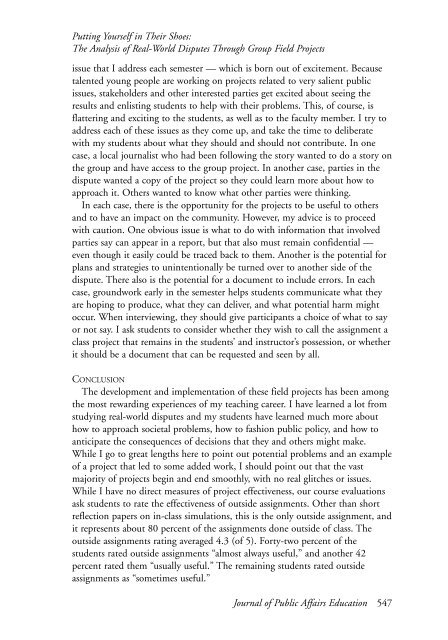JOURNAL OF PUBLIC AFFAIRS EDUCATION - National ...
JOURNAL OF PUBLIC AFFAIRS EDUCATION - National ...
JOURNAL OF PUBLIC AFFAIRS EDUCATION - National ...
Create successful ePaper yourself
Turn your PDF publications into a flip-book with our unique Google optimized e-Paper software.
Putting Yourself in Their Shoes:<br />
The Analysis of Real-World Disputes Through Group Field Projects<br />
issue that I address each semester — which is born out of excitement. Because<br />
talented young people are working on projects related to very salient public<br />
issues, stakeholders and other interested parties get excited about seeing the<br />
results and enlisting students to help with their problems. This, of course, is<br />
flattering and exciting to the students, as well as to the faculty member. I try to<br />
address each of these issues as they come up, and take the time to deliberate<br />
with my students about what they should and should not contribute. In one<br />
case, a local journalist who had been following the story wanted to do a story on<br />
the group and have access to the group project. In another case, parties in the<br />
dispute wanted a copy of the project so they could learn more about how to<br />
approach it. Others wanted to know what other parties were thinking.<br />
In each case, there is the opportunity for the projects to be useful to others<br />
and to have an impact on the community. However, my advice is to proceed<br />
with caution. One obvious issue is what to do with information that involved<br />
parties say can appear in a report, but that also must remain confidential —<br />
even though it easily could be traced back to them. Another is the potential for<br />
plans and strategies to unintentionally be turned over to another side of the<br />
dispute. There also is the potential for a document to include errors. In each<br />
case, groundwork early in the semester helps students communicate what they<br />
are hoping to produce, what they can deliver, and what potential harm might<br />
occur. When interviewing, they should give participants a choice of what to say<br />
or not say. I ask students to consider whether they wish to call the assignment a<br />
class project that remains in the students’ and instructor’s possession, or whether<br />
it should be a document that can be requested and seen by all.<br />
CONCLUSION<br />
The development and implementation of these field projects has been among<br />
the most rewarding experiences of my teaching career. I have learned a lot from<br />
studying real-world disputes and my students have learned much more about<br />
how to approach societal problems, how to fashion public policy, and how to<br />
anticipate the consequences of decisions that they and others might make.<br />
While I go to great lengths here to point out potential problems and an example<br />
of a project that led to some added work, I should point out that the vast<br />
majority of projects begin and end smoothly, with no real glitches or issues.<br />
While I have no direct measures of project effectiveness, our course evaluations<br />
ask students to rate the effectiveness of outside assignments. Other than short<br />
reflection papers on in-class simulations, this is the only outside assignment, and<br />
it represents about 80 percent of the assignments done outside of class. The<br />
outside assignments rating averaged 4.3 (of 5). Forty-two percent of the<br />
students rated outside assignments “almost always useful,” and another 42<br />
percent rated them “usually useful.” The remaining students rated outside<br />
assignments as “sometimes useful.”<br />
Journal of Public Affairs Education 547

















